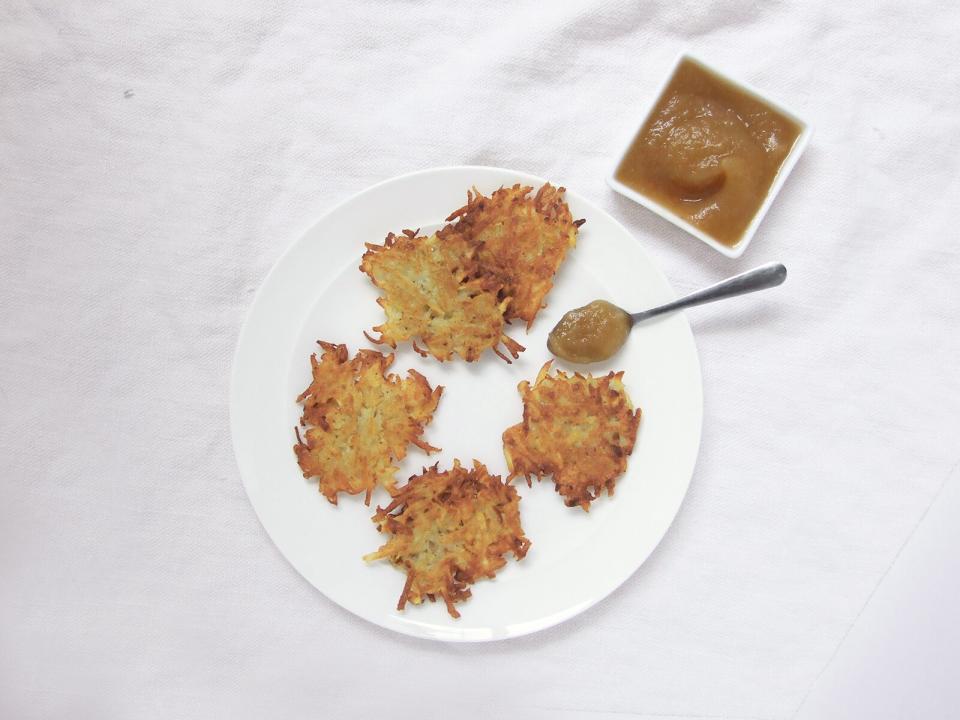11 Tips for Perfectly Crispy Latkes, Every Time

Getty Images
Fried lakes are delicious, no matter which way you slice them. But perfectly cooked potato pancakes—crispy on the outside, creamy on the inside—are nirvana. We fried up batches and batches to get the technique just right.
Here's how to master your best latke recipe. We recommend reading up before you get grating.
Know your spuds
Yukon golds are great for potato salad and red potatoes are lovely for roasting. But when it comes time for frying, it’s russets you want to seek out. Why? These classic potatoes have the high starch content that’s necessary to make sure your pancakes don't fall apart.
RELATED: The Best Potatoes to Use for Each of Your Favorite Tater Recipes

Grate your potatoes
If you’re not short on time, grate your potatoes on the large holes of a box grater instead of prepping them with a food processor. The box grater will yield thinner strands, which make for wispier, crispier latkes. Placing the grater on top of a dish towel (which you’ll use to wring out the potatoes later) also helps cut down on cleanup. As for onions, it’s fine to use the food processor, since grating them is a needlessly tear-jerking experience.
Eliminate moisture
Divide your shredded potatoes and onions into small batches, wrap them in a dish towel or cheesecloth, and give them a really good wringing. The desired result is potatoes that feel dry to the touch. This step is crucial, because water inhibits the chemical reactions that occur when food gets crispy. In other words, damp potatoes = soggy latkes.
RELATED: What Is the Maillard Reaction—and Why Understanding It Will Make You an Infinitely Better Cook
Save the starch—or add matzo meal
The water you wring from the potatoes will be packed with starch, and many cooks swear by adding a bit of it back to your latke mixture. But we found that adding a bit of flour (or better yet, matzo meal) does the same trick—and soaks up extra moisture at the same time.
Pick the proper pan
That is to say, a pan that can withstand high temperatures, heats evenly, and has enough room to hold a few potato pancakes at the same time without stacking. Nonstick cookware is generally only meant for using over low to medium heat, so opt for an uncoated stainless steel skillet (just make sure to use plenty of oil) or cast iron instead.
Get it hot
Set your pan over medium-high heat and pour in an oil with a high smoke point (such as canola or vegetable). Let the pan rest for a minute or so, then drop a little clump of potato into the oil to test the temperature. If the oil sizzles, it’s hot enough for frying. Make sure to change the oil between batches if stray potato pieces remain (otherwise they’ll burn and turn the oil bitter).
Pack loosely
Latkes are like the rest of us: they need their space. So, when you’re dropping spoonfuls (about 1/4 cup) of potato into the pan, work in batches and gently spread the mounds out for lacy, extra crisp latkes.
Resist the urge to fuss as they fry
Pushing, poking, and prodding at your precious latkes won't do you any favors—the goal is to allow them to fry until they're perfectly golden brown (read: not smashed and waterlogged in their own juices). Flip them once and let them fry until they're crisp and lightly browned. This is typically around 4 to 5 minutes per side.
Serve them hot
Timing is everything. You can use several pans at once to cook off your latkes more quickly. At the same time, set a wire rack inside of a baking sheet and place it in a 200°F oven. Then transfer the cooked latkes to the rack to keep them warm until the entire batch is finished.
Get creative with toppings
Apple sauce and sour cream are the traditional toppings, and absolutely necessary options. But why not shake things up a bit this year? Try mixing fresh herbs into your potato-onion batter, and go to town with a buffet of other delicious sauces and dips: pesto, chutney, marinara, salsa, eggplant dip... opportunities are endless.
Clear the air
Eliminating greasy odors after cooking latkes can be difficult, even after giving the stove a deep clean. Our favorite trick? Place several bowls filled with water and distilled white vinegar around the kitchen overnight. They’ll absorb any off smells.
RELATED: The 9 Commandments for Cooking Perfectly Crispy Oven-Roasted Potatoes

